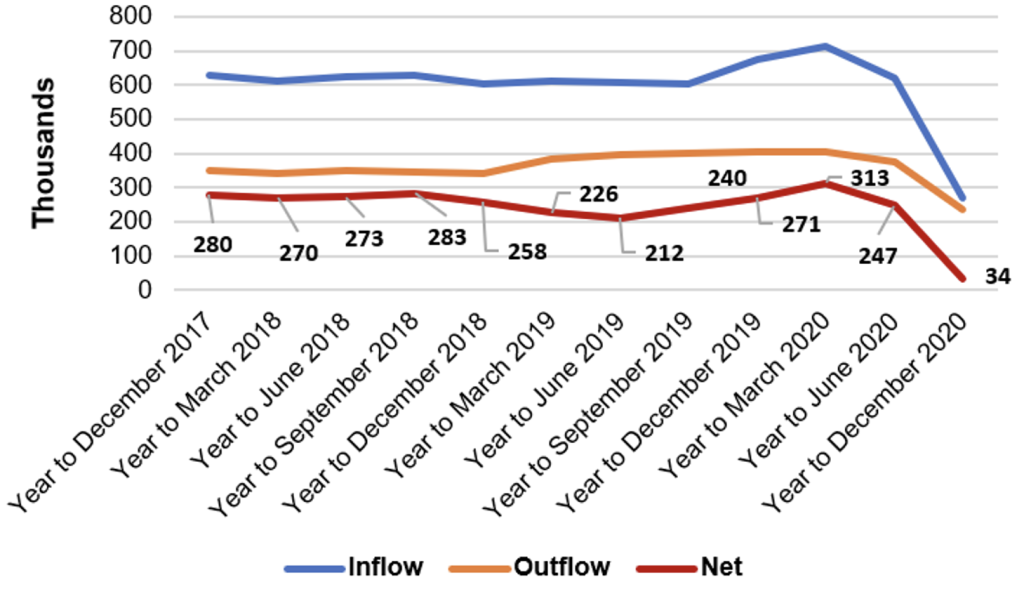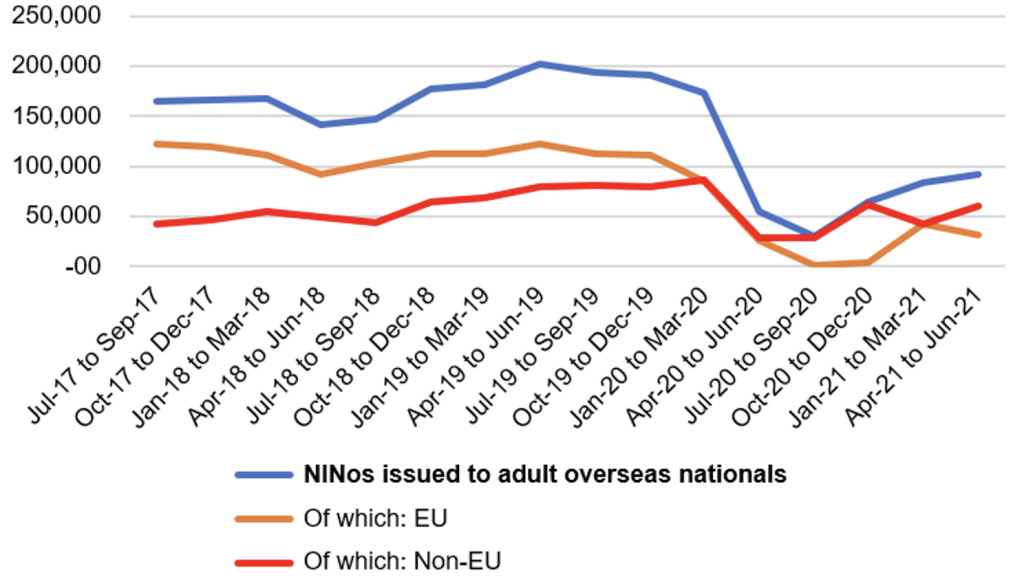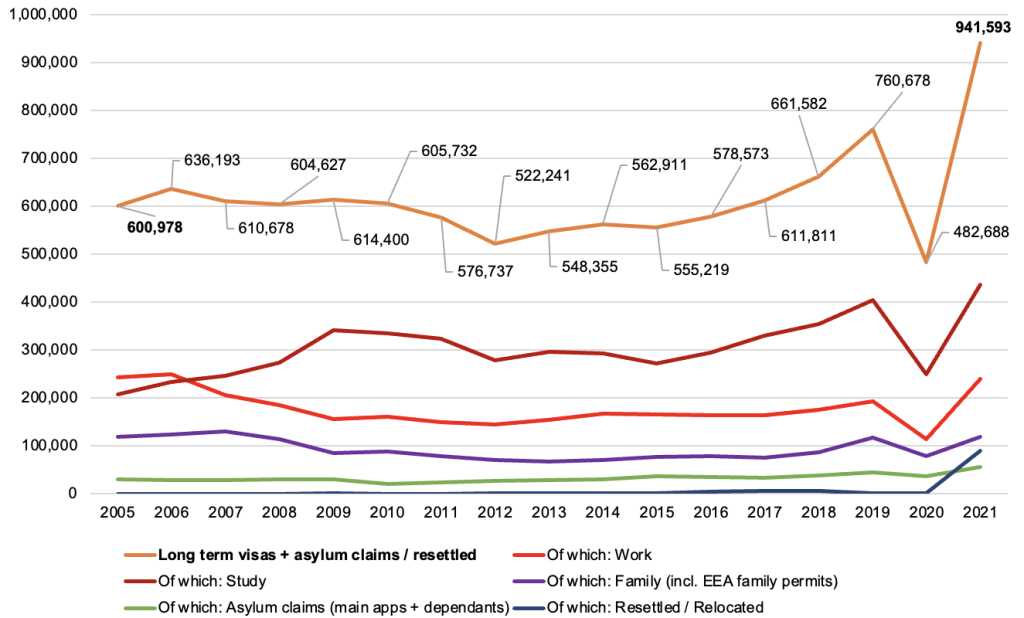
Summary: Immigration reached a near-record level of 313,000 in early 2020 but then fell in the midst of travel restrictions occasioned by the Covid pandemic in late 2020 and early 2021. However, visa and National Insurance Number data suggest that immigration, especially from outside the EU, fell by less than immigration from the EU, and may have increased rapidly during the latter part of 2021. Nearly a million people both from the EU and outside the EU were either given permission to come / stay or claimed asylum during 2021.
1. The Office for National Statistics (ONS) will release provisional estimates for what they think the level of immigration was in the year to June 2021 on 30 March 2022 at 9.30am (see link). What does the ONS think has happened to immigration in the past two years – since the onset of the Covid pandemic in March 2020?
2. The below graph shows the latest figures up to 2020, with the red line representing the net figure of gross inflows minus gross outflows. It shows a sizeable drop in immigration from its near-record level of 313,000 in March 2020 through the rest of that year.
Figure 1: Latest estimate of immigration levels by the Office for National Statistics. Until the year to March 2020, the figures are based upon the International Passenger Survey. After that they are based on ad-hoc and experimental provisional modelled estimates.

3. It should be stressed that the net migration estimates for both the year to June 2020 and to December 2020 are what the ONS calls ‘an indicative picture of what migration may have looked like in the first few months of the coronavirus pandemic by bringing together a range of data sources to model migration patterns’. They are based on modelling and only ‘provisional’. They also note that these are likely to be amended at a later date. They state that, because of the nature and the assumptions of the model, the modelled estimates ‘do not paint a complete picture of international migration’. While providing a headline measure for the UK, broken down by broad category of citizenship, they do not provide information on country of origin or destination, or reason for migration, for example.
4. The ONS announced in August 2020 that it would not return to producing official migration statistics based on its tried and tested method of the International Passenger Survey (IPS) – in place since the 1960s – and suspended the IP, instead shifting to a new (albeit untested and nebulous) approach relying on administrative data (admin-based migration estimates or so-called ABMEs).
5. The Department for Work and Pensions’ (DWP) Registration and Population Interaction Database (RAPID) – which is largely dependent on data on the allocation of National Insurance numbers to adult overseas nationals but also the PAYE system – and Home Office (HO) Border Data are seen by the ONS as the two key sources with the greatest potential for measuring long-term international migration instead of the IPS which they say was too unreliable to use.
6. The ONS said the IPS was unfit for purpose and summarily ended its use in measuring immigration despite naming it in 2018 as ‘the best source of information to measure long-term international migration’ (see Hansard).
7. Their stated goal for the new ABMEs is to provide coherent statistics that are timely and provide the level of granularity and insight that users need. “By linking data such as RAPID and Home Office border data together, we can overcome challenges in quality and coverage of using the sources on their own.” However, dependence on RAPID has been called into question by the recent suspension of the latest statistics on National Insurance Numbers from June 2021 onwards.
8. This is doubly concerning because the ONS said that the upcoming modelled estimates published by March aim to introduce RAPID data into the modelling for the first time. This method is also based on actual behaviours, which means waiting before a person has moved to the UK or left the UK for at least 12 months. Therefore, there will be time lags if this source is used in isolation. Hence modelling and later revisions. This is confusing and bizarre, and muddies accountability and transparency on immigration.
9. We have long said that instead of dropping use of the IPS its function should have been retained and gradually optimised until a reliable replacement method was in place to measure immigration.
10. In the interim, while we wait for a clearer picture, we can look at data hints on immigration from other sources including 1) National Insurance Number (NINO) allocations to adult overseas nationals and 2) visa issuance data / asylum and resettlement figures issued by the Home Office.
11. The graph below shows the trend for NINOs since 2017 and indicates (as does the net migration graph above) a notable drop, but this one chiefly driven by a fall in registrations by EU nationals. In contrast the non-EU numbers by mid-2021 were comparable to pre-pandemic numbers and even exceeded those seen in 2017 and 2018.
Figure 2: National Insurance Numbers allocated to non-UK nationals to mid-2021

12. The limitation of NINo allocation data is that it does not necessarily represent immigration due to a time lag between people arriving and NINo registration. It also excludes people who are not interacting with the employment, tax or benefit systems. So we need to also look at visas issued.
13. Latest Home Office visa, permit and asylum and resettlement figures (issued in late February 2022) show that the year 2021 saw approaching a million people either granted permission to come here, claim asylum here or given permission to resettle here permanently (see graph below).
Figure 3: Home Office immigration figures released late February 2022.

